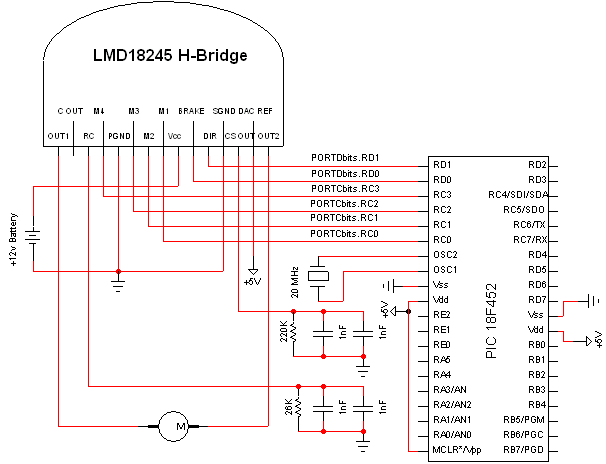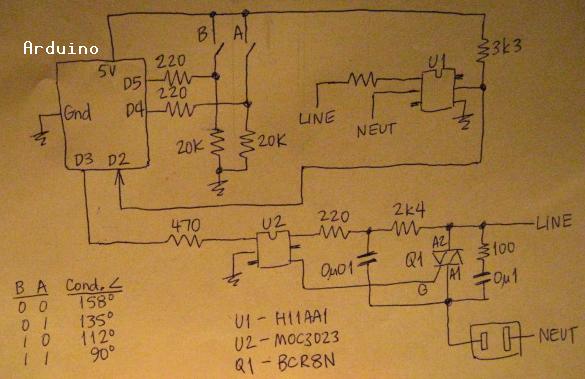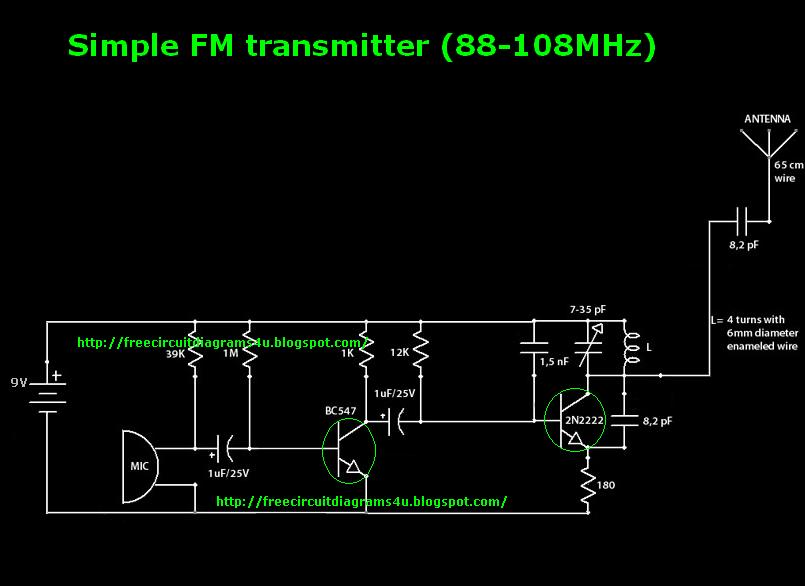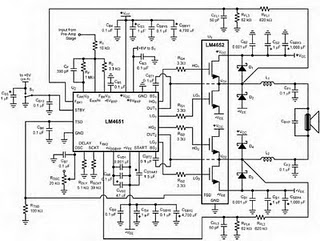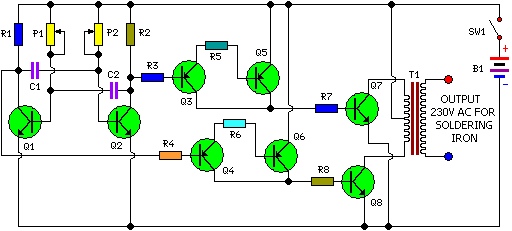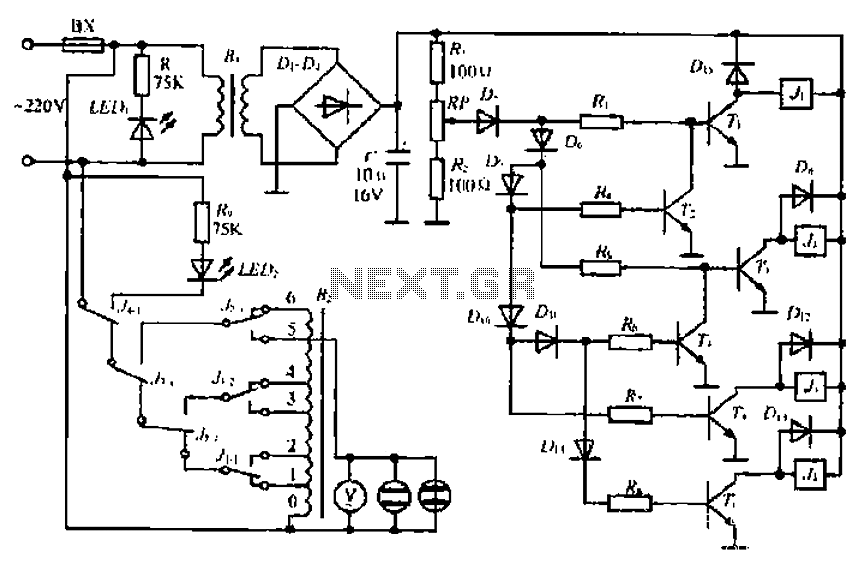
Pyroelectric automatic door control circuit
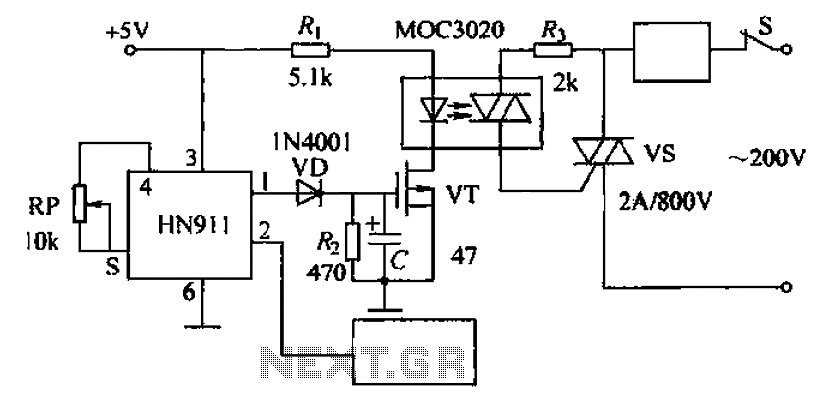
Automatic door control circuit diagram. It utilizes a pyroelectric infrared detection module, HN911, for human motion detection. A variable resistor (potentiometer) is used to adjust the delay time controlled by a transistor (VT). An optocoupler (MX: 3020) provides AC and DC isolation. When no motion is detected, the output terminal (O) of the HN911 is low, resulting in no control signal output from VT, causing the triac (VS) to remain closed and the electric load (door mechanism) to remain inactive. When a person approaches, the HN911 module detects infrared radiation, causing the output terminal (O) to go high, which triggers the conduction of a thyristor (VT2) and activates the motor to open the automatic doors. The operation of the automatic doors is halted by a limit switch (S), which cuts off the power when the doors reach their open position. The output from the HN911 can also be used to control the automatic door closure.
The automatic door control circuit leverages the HN911 pyroelectric infrared detection module to sense human presence through infrared radiation emitted by the human body. The HN911 module is sensitive to changes in infrared levels, which allows it to detect motion effectively. The output from the module is connected to a transistor (VT), which serves as a delay control mechanism. The delay is adjustable via a potentiometer, allowing for customization based on the specific application requirements.
The circuit design includes an optocoupler (MX: 3020) that provides electrical isolation between the control circuit and the load circuit. This isolation is crucial for protecting sensitive components from voltage spikes or noise that may occur in the load circuit, ensuring reliable operation.
In the absence of detected motion, the HN911's output remains low, resulting in no activation of the control signal from VT. Consequently, the triac (VS) remains off, and the electric load, which operates the door mechanism, is inactive, keeping the door closed.
Upon detecting motion, the HN911's output switches to high, which activates the thyristor (VT2). This action enables current to flow to the motor, which opens the automatic doors. The operation of the doors is monitored by a limit switch (S) that is triggered when the doors reach their fully open position, cutting off power to the motor and stopping further operation.
The design also incorporates a feedback mechanism for controlling door closure. The output from the HN911 can be utilized not only for opening the doors but also for signaling when to close them, enhancing the functionality of the automatic door system. This comprehensive approach ensures that the automatic door operates efficiently and safely in response to human presence. Automatic door control circuit diagram. Human motion detection using the new pyroelectric infrared detection module HN911. VT used as a delay control by adjusting potentiometer RP, can change the delay time control dummy. Optocoupler tuner MX: 3020 from AC and DC isolation. When no one walking time. HN911 output terminal O is low early. VT No control signal output, Triac vs closed, the load electric machine does not work, the door is closed. When someone approaching from the time gates. HN911 module detects infrared body radiation energy, the output terminal O is high, two-way goods thyristor VT2 conduction, load motor working, open the automatic doors.
When the automatic doors running in place, by the limit switch S off the power. Since HN911 output of block output level and the output of the opposite O level, it can be used the output terminal output control automatic door closed.
The automatic door control circuit leverages the HN911 pyroelectric infrared detection module to sense human presence through infrared radiation emitted by the human body. The HN911 module is sensitive to changes in infrared levels, which allows it to detect motion effectively. The output from the module is connected to a transistor (VT), which serves as a delay control mechanism. The delay is adjustable via a potentiometer, allowing for customization based on the specific application requirements.
The circuit design includes an optocoupler (MX: 3020) that provides electrical isolation between the control circuit and the load circuit. This isolation is crucial for protecting sensitive components from voltage spikes or noise that may occur in the load circuit, ensuring reliable operation.
In the absence of detected motion, the HN911's output remains low, resulting in no activation of the control signal from VT. Consequently, the triac (VS) remains off, and the electric load, which operates the door mechanism, is inactive, keeping the door closed.
Upon detecting motion, the HN911's output switches to high, which activates the thyristor (VT2). This action enables current to flow to the motor, which opens the automatic doors. The operation of the doors is monitored by a limit switch (S) that is triggered when the doors reach their fully open position, cutting off power to the motor and stopping further operation.
The design also incorporates a feedback mechanism for controlling door closure. The output from the HN911 can be utilized not only for opening the doors but also for signaling when to close them, enhancing the functionality of the automatic door system. This comprehensive approach ensures that the automatic door operates efficiently and safely in response to human presence. Automatic door control circuit diagram. Human motion detection using the new pyroelectric infrared detection module HN911. VT used as a delay control by adjusting potentiometer RP, can change the delay time control dummy. Optocoupler tuner MX: 3020 from AC and DC isolation. When no one walking time. HN911 output terminal O is low early. VT No control signal output, Triac vs closed, the load electric machine does not work, the door is closed. When someone approaching from the time gates. HN911 module detects infrared body radiation energy, the output terminal O is high, two-way goods thyristor VT2 conduction, load motor working, open the automatic doors.
When the automatic doors running in place, by the limit switch S off the power. Since HN911 output of block output level and the output of the opposite O level, it can be used the output terminal output control automatic door closed.
Warning: include(partials/cookie-banner.php): Failed to open stream: Permission denied in /var/www/html/nextgr/view-circuit.php on line 713
Warning: include(): Failed opening 'partials/cookie-banner.php' for inclusion (include_path='.:/usr/share/php') in /var/www/html/nextgr/view-circuit.php on line 713
